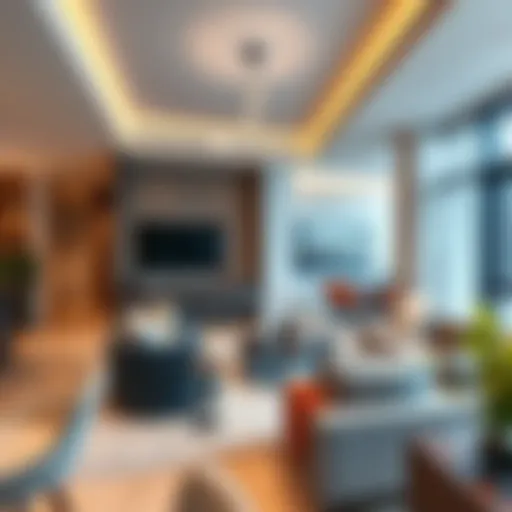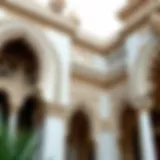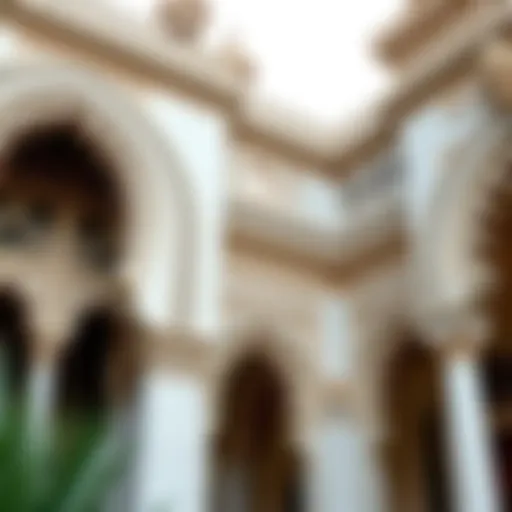Exploring the Dubai Venice Canals: Urban Living Redefined
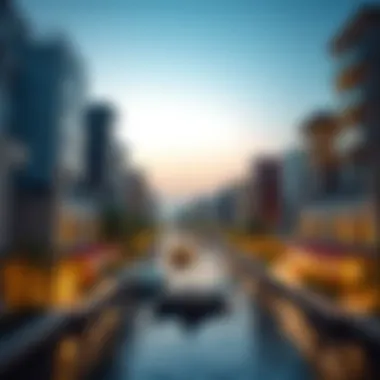

Market Trends
The emergence of the Dubai Venice Canals marks a significant shift in the landscape of urban living, melding cultural richness with architectural innovation. As this development paves the way for a new form of real estate investment, it is essential to analyze current market trends and how they shape the consumer landscape.
Current Market Analysis
The recent expansion of the Dubai Venice Canals indicates a burgeoning interest in properties that offer luxurious water-front living. The allure of owning a property along these canals is profound, as both residents and investors are increasingly leaning towards homes that provide scenic views and a sense of tranquility amidst the urban hustle. As of late 2023, there has been a noticeable uptick in property values around this area, driven primarily by the unique lifestyle options and amenities introduced by the canals.
According to local real estate experts, properties with direct access to water are commanding higher prices compared to their landlocked counterparts. The median price per square foot has risen significantly, reflecting buyers' enthusiasm for this blend of leisure and lifestyle.
"Investing in properties near the Dubai Venice Canals is not just about real estate; it’s about embracing a lifestyle that resonates with luxury and leisure." - Real Estate Analyst
Future Projections
Looking forward, the projections for investment in the Dubai Venice Canals remain optimistic. Urban planning initiatives indicate that as more infrastructure develops around these canals, including retail spaces and recreational areas, the demand for real estate will continue to soar. According to forecasts made by the Dubai Land Department, residential property prices in and around the canals could increase by as much as 15% over the next three years.
Investors keen on maximizing their returns should note that these price elevations correspond with global real estate trends favoring waterfront properties. The integration of luxury features such as private docks and pedestrian-friendly walkways will further enhance the areas' appeal. Furthermore, as Dubai positions itself as a more attractive destination for tourism and expatriate living, the significance of the Venice Canals will only amplify in the competitive market of urban developments.
Investment Strategies
With the promising trends in mind, adopting effective investment strategies becomes essential for potential buyers.
Best Neighborhoods to Invest In
While the Venice Canals themselves are the focal point of interest, there are several adjoining neighborhoods worth noting. These neighborhoods not only enhance your investment's value but also improve the quality of life for residents. Among the top areas:
- Jumeirah Beach Residence: Known for its vibrant community and beach access
- Dubai Marina: Offers a blend of upscale living and entertainment options
- Downtown Dubai: Houses international business districts and cultural centers
Having a foot in these prime locations can provide a substantial return on investment, especially as the connectivity and tourism around the canals grows.
Tips for First-Time Investors
For those gearing up to enter the real estate market, here are some pro tips:
- Research Thoroughly: Look into past performance statistics of similar properties.
- Consult Local Experts: Engage with real estate agents who have in-depth knowledge of the Dubai market. They can offer insights that statistics alone might not reveal.
- Magnify Long-Term Vision: Focus on long-term potential rather than immediate gains. Urban developments like the Venice Canals need time to mature into their full value.
- Explore Financing Options: Understand pathways to financing that may be available to foreign investors, as Dubai offers various options that can benefit you.
Overview of the Dubai Venice Canals
The Dubai Venice Canals present a bold foray into the synthesis of modern urban living and timeless architectural elegance. Capturing attention on both a local and global scale, these canals serve not only as a striking visual element but also as a centerpiece for defining urban interactions within the city. In a landscape famed for its towering skyscrapers and multiple attractions, this project introduces a different dimension—one that invites both serenity and vibrancy into Dubai’s otherwise bustling environment.
The importance of exploring the Dubai Venice Canals cannot be overstated; these waterways form an integral part of the urban tapestry, impacting real estate, community cohesion, and cultural identity. Here are some benefits and considerations:
- Enhancing Property Values: With luxurious waterfront locations being a hallmark of desirability, the introduction of canals immediately boosts property allure. Homeowners and investors alike should recognize that properties in proximity to water tend to command higher prices, driven by demand for exclusive lifestyles.
- Community Connectivity: The canals’ design encourages pedestrian and cyclist interactions, fostering a sense of place and enhancing lifestyle quality. As people gather along the picturesque banks, social engagement flourishes.
- Environmentally Thoughtful: Integrating water features into urban spaces comes with advantages for the environment as well. Canals can help manage flood risks, improve local microclimates, and provide habitats for various wildlife.
"The project isn’t just about looks; it’s about creating a harmonious ecosystem where community thrives and real estate flourishes."
- Tourism Appeal: Dubai has long been a hotspot for tourists, and the canals offer new attractions, from gondola rides to waterside cafes, amplifying the city’s allure. Tourists are likely to flock to these spots, adding economic benefits.
In sum, the Dubai Venice Canals signify a strategic blend of aesthetics, functionality, and sustainability, thereby crafting a comprehensive approach to urban living. By delving into the vision behind this project, the architectural features, and the historical influences that shaped its conception, a clearer picture of its significance begins to emerge.
Design Elements of the Canals
The design elements of the Dubai Venice Canals stand as a testament to urban innovation and aesthetic elegance, weaving together functionality with beauty. These canals not only serve as picturesque features but also significantly enhance how residents and visitors experience urban living. The intricate planning that goes into these elements contributes to the overall vision of creating a unique lifestyle space that marries water with terrestrial elements, setting a new standard for urban environments.
Landscape Architecture
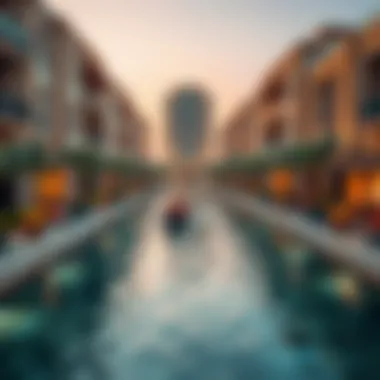

Landscape architecture within the Dubai Venice Canals embodies a harmonious blend of nature and engineering. This isn’t just about placing a few trees or shrubs; it’s a calculated orchestration of various types of flora that thrive in Dubai’s hot climate. These plants are strategically chosen to provide shade, promote biodiversity, and contribute to the overall aesthetics of the environment.
Considerations such as the seasonal blooming of flowers and the growth patterns of trees ensure that there is always something visually captivating throughout the year. The pathways lined with bougainvillea and palms aim to entice pedestrians to stroll leisurely along the water’s edge.
"Nature doesn’t hurry, yet everything is accomplished." – Lao Tzu
This principle applies well here, as the landscape architecture transforms into a slow-paced oasis amidst a bustling city.
Waterfront Development
Waterfront development is a cornerstone of the canal’s design, focusing on creating a vibrant, interactive environment. This aspect caters not only to aesthetic sensitivity but also provides functional spaces for retail and leisure activities. Cafés and restaurants spilling out onto promenades invite social interaction, while boat rides and gondola systems offer unique means of transportation within the city.
The integration of logs, benches, and recreational facilities alongside the waterfront encourages community engagement. It is designed for people to linger, relax, and enjoy the scenery. Properties close to these waterfronts have seen an uptick in desirability, turning views of the water into economic opportunities for homeowners and real estate developers alike.
Integration with Surrounding Structures
One of the more impressive feats of the Dubai Venice Canals is their seamless integration with the surrounding urban fabric. Rather than existing in isolation, these canals connect and interact with nearby residential and commercial areas, providing a continuous narrative of urban living. This thoughtful blending helps create a robust sense of place and community.
High-rise developments flank the canal, their architecture carefully designed to complement the flowing lines of the water. Bridges, walkways, and leisure areas create nodes of activity that draw people together. This connective tissue between buildings and waterways encourages a mixed-use environment where living, dining, and recreation coalesce.
Ultimately, the design elements of the Dubai Venice Canals articulate a vision that transcends traditional urban planning. They emphasize the importance of water features as a central component of urban life, creating spaces that are not just livable but delightful, inspiring a lifestyle firmly anchored in both beauty and functionality.
Cultural Significance of the Canals
The Dubai Venice Canals represent more than just a modern engineering marvel; they serve as a vital cultural nexus that reflects both the city's aspirations and its complex relationship with tradition. As urban environments become increasingly intertwined with nature, the canals offer a chance to explore cultural identity through waterway design, reminiscent of Italy's renowned Venice. This section delves into how these canals mirror Venetian aesthetics, influence local traditions, and foster art and community events, thereby enriching the cultural fabric of Dubai.
Reflection of Venetian Aesthetics
When one strolls alongside the Dubai Venice Canals, it’s easy to draw parallels with the iconic waterways of Venice. The canals are designed with intricate bridges, charming walkways, and a series of picturesque vistas that harken back to the romantic essence of Italy's labyrinthine waterways. Lush landscaping adds to the charm, creating a serene atmosphere that attracts both residents and visitors alike.
In architecture, features such as shaded loggias and arched facades highlight the influence of Venetian styles. This aesthetic not only enriches the visual appeal but also serves as a reminder of the deep-rooted maritime culture that has shaped many civilizations. The artistic choices made in the design reflect a conscious effort to adopt and adapt elements from Venice while integrating them within Dubai’s own cultural context.
“Cities are the memories of mankind. The canals are a vibrant reminder of the interconnectedness of life.”
Influence on Local Traditions
The introduction of the canals has sparked curiosity and a rekindling of interest in local traditions. By creating these water features, Dubai encourages activities such as traditional boat rides, bringing back an ancient method of transport that echoes the past. This revival also allows for gatherings that celebrate Emirati customs, such as festivals or cultural exhibitions, cultivating a sense of community that is often overlooked in the hustle of urban living.
Local artisans and cultural groups have found in these canals a canvas to showcase their work. From handcrafted wooden dhows that reflect traditional boat-building techniques to performances celebrating Emirati folklore, the canals have become a stage for various cultural expressions, contributing to a vibrant tapestry of local heritage.
Art and Community Events Around the Canals
Art takes on new forms near the canals, with both permanent installations and temporary exhibits appearing regularly. Artists are inspired by the waterways and surrounding environments, using them as backdrops for public art that combines contemporary themes with historical narratives. The canals host community events that range from open-air concerts to art fairs, promoting engagement with both the space and its artistic interpretations.
Additionally, seasonal festivals, such as the Dubai Water Week, draw crowds to celebrate water-related issues through art, environmental awareness, and community participation. This fusion of art and community fosters a stronger connection among residents and visitors, transforming the canals into living spaces rather than mere aesthetic features.
Thus, the Dubai Venice Canals are more than a novel urban feature; they are a platform for cultural expression, a reflection of history, and a catalyst for community engagement. The significance of the canals lies not only in their construction but also in their ability to nurture and celebrate the vibrant culture of Dubai.
Impact on Dubai's Real Estate Market
The Dubai Venice Canals stand as a remarkable example of innovative urban development, profoundly influencing the real estate landscape of the city. As the project unfolds, it intertwines with the dynamics of property demand, investment opportunities, and long-term economic advantages—elements that are crucial for potential investors, real estate agents, and homeowners alike.
Property Demand and Investment Opportunities
With the emergence of the Dubai Venice Canals, a notable spike in property demand is evident. This new waterfront development has shifted the spotlight on real estate investment, drawing local and international buyers eager to snag their piece of this vibrant locale. The attraction to these canals is not only about aesthetics but also convenience and lifestyle.
- Key drivers of demand include:
- Proximity to leisure and cultural venues
- Enhanced lifestyle offerings that blend urban living with natural elements
- Potential for high rental yields due to increased tourism and interest in the area


Investors are keen to tap into the market as it shows promise for growth. The interest in waterfront properties typically suggests that buyers are not just looking for homes; they desire a lifestyle. And it seems like Dubai's Venice Canals will deliver just that.
Comparative Market Analysis with Other Waterfront Developments
When considering the Dubai Venice Canals, it is imperative to conduct a comparative analysis against other prominent waterfront developments globally. Notably, the success of Venice’s canals and their historical significance presents both inspiration and caution for developers in Dubai.
In areas like New York’s Hudson River Park and Miami’s waterfront nexus, real estate thrives as access to water features enhances property value. Dubai's endeavor into canal development puts it on the global map, aligning it with cities renowned for their unique waterfront offerings.
- Factors to compare include:
- Pricing strategies
- Construction quality and innovative architecture
- Community amenities that promote engagement and leisure
Investors should particularly look at how these factors influence market dynamics, providing them insights into prospective pricing trends and viability for investment in Dubai’s real estate sector.
Long-Term Economic Benefits
As with any substantial real estate project, the long-term economic benefits of the Dubai Venice Canals merit significant attention. On one hand, they are likely to catalyze growth in the tourism sector, as the canals are expected to attract visitors from across the globe.
This development fosters job creation not just during the construction phase but also for operations, hospitality, and retail sectors.
- Potential benefits include:
- Job creation in tourism, hospitality, and maintenance sectors
- Increased tax revenues for local government due to thriving businesses
- Enhanced property values resulting in a robust real estate market
Challenges and Controversies
The Dubai Venice Canals project, despite its innovative appeal, is not without its share of challenges and controversies. Delving into these aspects is crucial as it highlights not just the potential pitfalls but also the broader implications on environmental and social dynamics within urban settings. A detailed examination of these challenges can foster a better understanding of how such ambitious projects can maintain a balance between development and sustainability.
Environmental Considerations
One of the predominant concerns associated with the Dubai Venice Canals is the environmental impact of constructing artificial waterways in a desert ecosystem. Critics argue that the introduction of large-scale water features can disrupt the delicate balance of the local environment. The construction process itself may result in habitat destruction, especially if it encroaches upon natural flora and fauna.
Furthermore, maintaining the water quality of the canals raises questions. In regions where the heat can soar, careful management is essential to avoid algae blooms and other issues that could compromise water purity. Ongoing studies about the ecological effects are vital. To mitigate these impacts, integrating efficient water management systems, such as closed-loop water recycling, may be necessary.
- Potential Solutions:
- Utilize smart technology for monitoring water quality.
- Implement green infrastructure around the canals.
Construction Challenges
Building a project of this magnitude poses its own set of construction hurdles. Dubai's unique climate and soil conditions contribute to complications that developers must address. For instance, the sandy terrain is not always conducive to traditional construction methods. This often mandates specialized machinery and innovative techniques to ensure stability and structural integrity.
Delays are another common issue. Factors such as logistical challenges, workforce availability, and supply chain disruptions can extend the timeline, ultimately impacting costs.
- Key Considerations:
- Assessing geological stability.
- Ensuring timely sourcing of materials.
Public Perception and Acceptance
Public sentiment towards the Dubai Venice Canals project is mixed, reflecting a spectrum of perspectives. Some residents embrace the idea of a Venice-inspired locale, viewing it as a cultural enrichment that enhances the city’s appeal. However, skepticism persists among others who question the necessity of such developments amidst pressing local issues, such as affordable housing.
Community engagement is critical in navigating these sentiments. Hosting public forums and information sessions can foster dialogue between stakeholders and the community, addressing concerns and highlighting the benefits of the canals.
- Community Feedback:
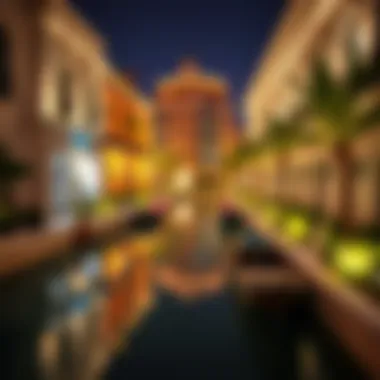

- Positive views often focus on tourism and lifestyle enhancement.
- Concerns suggest prioritizing local needs and sustainability over aesthetic appeal.
In summary, the Dubai Venice Canals' challenges and controversies offer a prism through which to examine broader issues in urban development. Addressing environmental impacts, construction hurdles, and public perceptions will be essential in shaping a project that is both innovative and respectful of existing urban dynamics.
Key Takeaway: Balancing ambitious urban projects with sustainability and community acceptance is a pivotal challenge for modern cities.
Future Prospects
The future of the Dubai Venice Canals undoubtedly harbors immense potential that goes beyond traditional urban development models. Positioned at the heart of Dubai's ambitious growth plans, these canals serve as a focal point for innovations in urban living. This chapter will delve into a triad of key future prospects: planned expansions and developments, technological innovations in urban water management, and sustainability practices that will define the trajectory of this urban marvel.
Planned Expansions and Developments
As the Dubai Venice Canals continue to evolve, there are significant expansions on the horizon. City planners have emphasized a commitment to creating interconnected waterways that enhance accessibility and link various precincts within the area. One can imagine vibrant promenades lined with cafes, boutique shops, and recreational spaces springing up along the canal banks. This not only promotes leisure and tourism but also sparks a buzz in the local economy.
In addition to enhancing aesthetic appeal, the planned developments aim to cater to a growing population. New residential complexes integrated with the waterfront will likely draw in families, young professionals, and expatriates who seek both luxury and community-centric living. The anticipated influx of visitors and residents could lead to an increased demand for diverse retail options and entertainment venues, thus stimulating job creation.
The proposed expansions will empower the canals to serve as a lifeblood of the community, weaving together living, leisure, and commerce.
Technological Innovations in Urban Water Management
Amidst the backdrop of climate change and urbanization, the Dubai Venice Canals project stands as a vanguard of smart city initiatives. This section explores the cutting-edge technologies that are being integrated into water management systems. Sensors for monitoring water quality, automated flood mitigation systems, and real-time data analytics are just a few innovations set to be implemented.
These technologies will not only improve the ecological balance of the canals but also ensure swift responses to environmental challenges. For instance, a sophisticated network could predict rainfall patterns and manage water levels effectively, helping to prevent flooding in the urban environment. This would contribute not only to enhancing the livability of the area but also to sustaining its natural beauty. In truth, intelligent water management may render the canals a model for future urban developments beyond Dubai.
Sustainability Practices in Urban Planning
Sustainability isn't merely a buzzword; it’s an essential consideration that permeates every aspect of urban planning today. The future of the Dubai Venice Canals will intertwine eco-friendly practices with expansive urban designs. A cornerstone of this approach will likely be the integration of green spaces and biodiversity within the urban landscape. Think parks that filter air and shade areas along the canals, or living roofs on buildings that contribute to reducing the urban heat island effect.
Moreover, energy-efficient designs will play a crucial role. Utilizing solar panels on buildings bordering the canals can harness the sun's energy, while rainwater harvesting techniques will encourage responsible water usage. This holistic view aims to create a cycle of sustainability that respects both ecological footprints and urban lifestyle needs.
This commitment to sustainable urban planning not only enhances the environment but also aligns with global sustainability goals, making the canals a beacon for environmentally conscious urban development.
The future prospects for the Dubai Venice Canals present an exciting tapestry of opportunities that hold the promise to redefine urban living. With deliberate planning, innovative technology, and a commitment to sustainability, this urban waterway can become a hallmark of modern city living, potentially setting an example for waterfront developments worldwide.
Comparative Analysis: Dubai and Venice
The exploration of the Dubai Venice Canals in comparison with their Venetian namesake provides a unique lens through which to understand urban development in diverse cultural contexts. This topic is essential as it highlights not only architectural and aesthetic parallels but also the broader implications of such endeavors on urban lifestyles, tourism, and real estate.
In a nutshell, examining these parallels aids investors, developers, and urban planners in grasping how cities can draw from each other's strengths while carving out their own identities. Both cities, although worlds apart, share aspirations of blending water and urban living, creating vibrant environments that attract both residents and tourists alike.
Architectural Similarities and Differences
Dubai and Venice, when boiled down to their architectural essence, present a study of contrasts intertwined with surprising similarities.
Venice is renowned for its narrow canals framed by ancient buildings and historic bridges that serve as cathedrals to the artistry of the past. The intricate design of these structures reflects centuries of history, offering a tangible narrative of evolution through architecture.
Conversely, the Dubai Venice Canals introduce a modern flair to the classic concept. The architecture here is characterized by sleek lines and contemporary glass facades, often accompanied by lush landscaping. While Venetian architecture invites nostalgia, Dubai's venture is a bold statement of innovation, appealing to a global audience. Both cities prioritize aesthetics in their waterways, but the execution is distinctly informed by their cultural contexts.
This architectural dichotomy not only defines the character of each canal city but also influences how residents and visitors experience them.
Cultural Exchange and Influence
Cultural exchange is fundamentally woven into the fabric of the Dubai Venice Canals. The project serves as a bridge between East and West, fostering interactions that enrich both locations. While Venice has long been a melting pot of influences due to its history as a trading hub, Dubai takes this a step further in contemporary times as a nexus of cultural fusion.
Local traditions have a way of shaping how the canals are utilized. Despite their Western inspiration, Dubai's canals lend themselves to the Emirati lifestyle, where family gatherings along the waterfront are commonplace. Simultaneously, Venetian festivals influence events hosted in Dubai, enhancing the cultural tapestry of both places.
Tourism Trends in Both Locations
The tourism landscape in Dubai and Venice offers further ground for comparison, specifically in how both cities leverage their beautiful canals to attract visitors. In Venice, tourism is often driven by its rich cultural heritage and historical significance, making it a perennial destination for those drawn to its charm.
In contrast, Dubai is fast establishing itself as a world-class traveler hub with features like the Venice Canals drawing curious tourists seeking modernity intertwined with tradition. The canals in Dubai provide a canvas for new experiences—water taxis, floating restaurants, and open-air markets enriching the visit.
The success of this development is evidenced by an increase in tourists, intrigued not just by the waterscape itself but also by the unique offerings that accompany it.
"Combining cultural heritage with modern amenities presents an exciting case study on tourism evolution in iconic cities."



